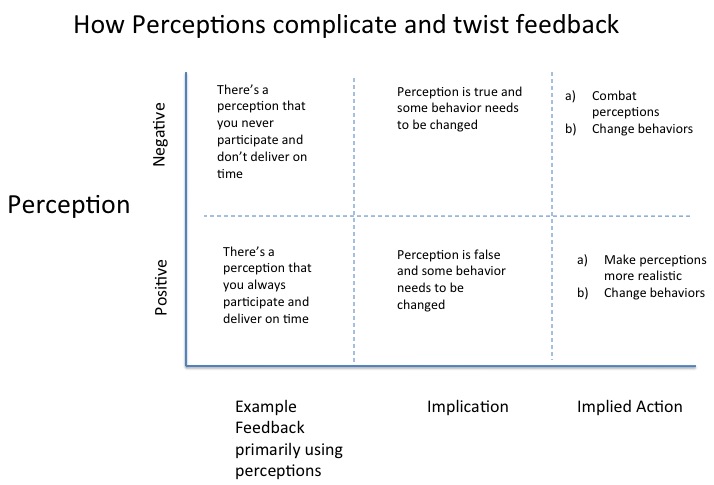Using perceptions to manage: Are positive perceptions cited?
Today I continue my extended series on managers using perceptions to manage the team. Imagine a manager who starts a performance feedback session with “There’s a perception that. . . you don’t actively participate.” Or “There’s a perception that. . . you’ve fallen behind on your work.”
I believe that these words, “There’s a perception that” need to be removed from a manager’s vocabulary. I provide three reasons here, Three more reasons here, and three more reasons here.
But I have more reasons! Today I examine why positive perceptions are not cited when managers manage perceptions.
10. “There’s a perception that. . .” is rarely used for positive things, underscoring the absurdity of the line
Have you ever noticed that a manager never sits down with an employee and says, “There’s a perception that you deliver on time with high quality and exceptional teamwork”? or “There’s a perception that you bring talents to the group that no one else has.” Or “There’s a perception that you designed and created an infrastructure that increased productivity by 40% and reduced costs by 60%”. Or perhaps a more pedestrian example, “There’s a perception that you’re always on time.”
Hmm. . . as soon as it’s positive things, the “perception” line seems to be unnecessary and weird. . .if the perception of the thing is a the positive thing. Managers who can articulate the positive thing don’t need to add the “There’s a perception that. . .”
11. It twists positive feedback into negative feedback even for positive behaviors and perceptions!
Let’s take a look at the below chart. In it we have an example of a manager giving negative “feedback” and positive “feedback” while inserting the “there’s a perception” line.
Normally, when you give positive feedback on something, it means that you want the employee to keep doing that behavior, or do it with more frequency. But in this chart, you can see that by adding the “there’s a perception” line to the positive feedback, the implication is that something is wrong – that the perception is false in some way and the perception needs to be adjusted to a more realistic perception. (Ironically, when the perception is a negative one, that perception is widely believed to be true.) On top of that, the implication is that the underlying behaviors that created that over-inflated perception also need to be changed so that future perceptions will be the more realistic perception.
So by adding the “there’s a perception” line to a positive behavior, it turns it into a negative perception and a negative behavior. Now the employee has to change both perceptions and the underlying behaviors – on something that is being praised!
In short, it becomes twisted when a positive perception implies that things need to change.
12. It complicates and what should be done differently
The point of feedback is to either change the behavior (corrective feedback) or extend the behavior (reinforcing feedback). But when adding the “There’s a perception” line to the feedback, it magnifies the complexity of what should be differently. In the negative feedback scenario, the employee needs to do two things: 1. Combat the perceptions and 2. Change the underlying behavior that created the perceptions. That’s really hard. Especially if you consider how the employee somehow got into the “negative perception” hole in the first place . . . now the feedback implies that the employee can somehow get out of it. Whatever created that negative perception in the first place was likely complex and external to the employee’s actual behaviors, so to imply that there’s a way to resolve this is a tall order.
In the positive feedback scenario, the employee is tasked with tempering the positive perception somehow, and with doing something differently that creates the (implied) overly positive perception. Both are complicated projects that are probably unending and unresolvable, and perhaps pointless.
When giving feedback, whether constructive or reinforcing, it is important to a) stick to the behavior that needs to change or continue – and b) to limit the discussion to as few behaviors as possible so that it is more accountable and actionable.
Adding the “there’s a perception that” line does the exact opposite of good practices in providing performance feedback.
Related articles:
Using perceptions to manage: What does this tell us about the manager’s feedback providing skills?
A tool for how to tell if feedback is relevant to your job
Performance feedback must be related to a performance
A model to determine if performance feedback is relevant to job performance
A second phantom job many employees have: Managing perceptions of others
Using perceptions to manage: How this undermines efforts for change




how should an employee respond to “there’s a perception that”